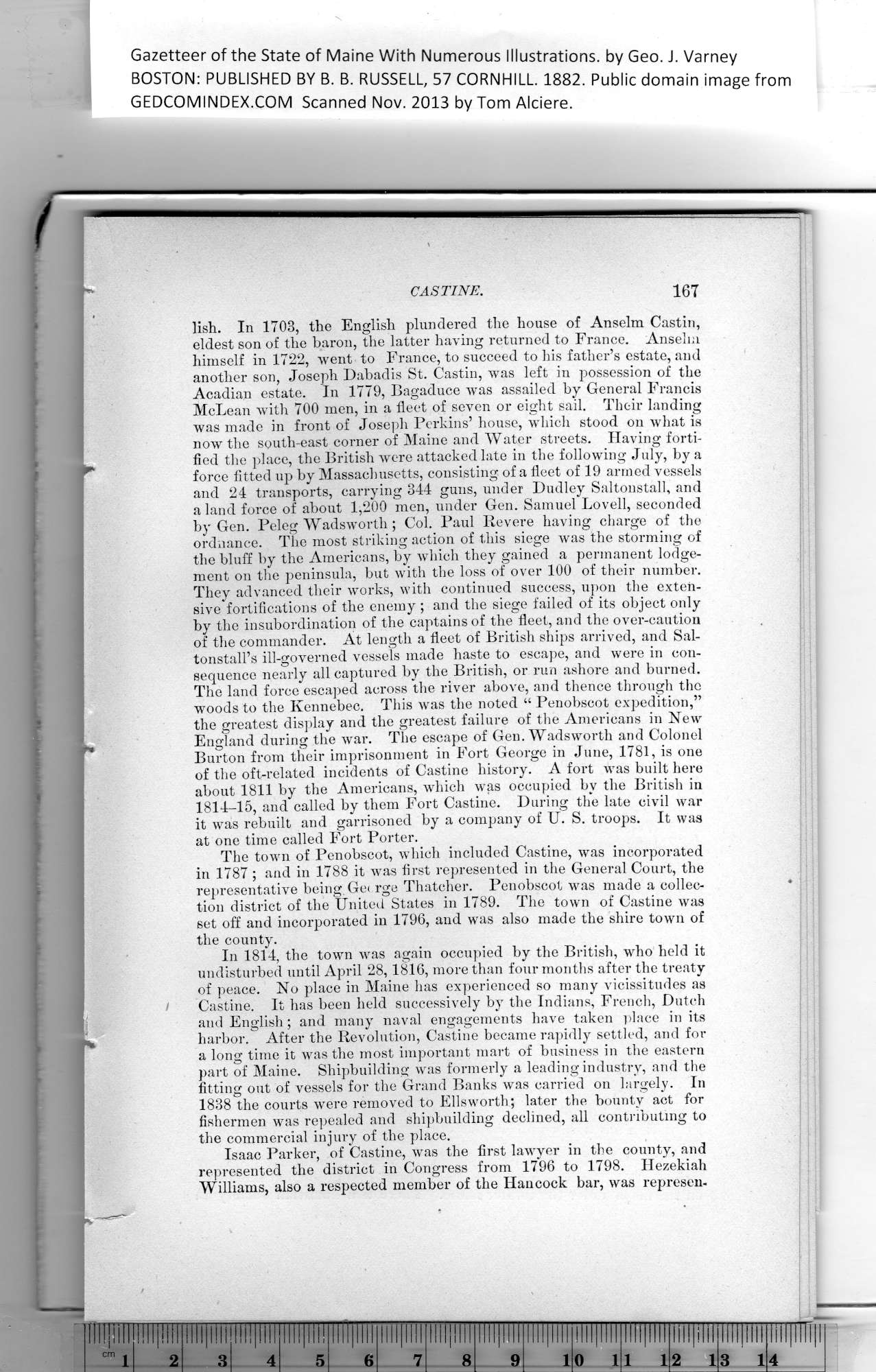|
Gazetteer of the State of Maine With Numerous Illustrations, by Geo. J. Varney
BOSTON: PUBLISHED BY B. B. RUSSELL, 57 CORNHILL. 1882. Public domain image from
CASTINE. 167
lish. In 1708, the English plundered the house of Anselm Castin,
eldest son of the baron, the latter having returned to France. Anselm
himself in 1722, went to France, to succeed to his father’s estate, and
another son, Joseph Dabadis St. Castin, was left in possession of the
Acadian estate. In 1779, Bagaduce wms assailed by General Francis
McLean with 700 men, in a fleet of seven or eight sail. Their landing
was made in front of Joseph Perkins’ house, which stood on what is
now the south-east corner of Maine and Water streets. Having forti-
fied the place, the British were attacked late in the following July, by a
force fitted up by Massachusetts, consisting of a fleet of 19 armed vessels
and 24 transports, carrying 344 guns, under Dudley Saltonstall, and
a land force of about 1,200 men, under Gen. Samuel Lovell, seconded
by Gen. Peleg Wadswmrth ; Col. Paul Revere having charge of the
ordnance. The most striking action of this siege was the storming of
the bluff by the Americans, by which they gained a permanent lodge-
ment on the peninsula, but with the loss of over 100 of their number.
They advanced their works, with continued success, upon the exten-
sive fortifications of the enemy ; and the siege failed of its object only
by the insubordination of the captains of the fleet, and the over-caution
of the commander. At length a fleet of British ships arrived, and Sal-
tonstall’s ill-governed vessels made haste to escape, and were in con-
sequence nearly all captured by the British, or run ashore and burned.
The land force escaped across the river above, and thence through the
woods to the Kennebec. This was the noted “ Penobscot expedition,”
the greatest display and the greatest failure of the Americans in New
England during the war. The escape of Gen. Wadsworth and Colonel
Burton from their imprisonment in Fort George in June, 1781, is one
of the oft-related incidents of Castine history. A fort was built here
about 1811 by the Americans, which was occupied by the British in
1814-15, and called by them Fort Castine. During the late civil war
it was rebuilt and garrisoned by a company of U. S. troops. It was
at one time called Fort Porter.
The town of Penobscot, which included Castine, was incorporated
in 1787 ; and in 1788 it was first represented in the General Court, the
representative being. Get.rge Thatcher. Penobscot was made a collec-
tion district of the United States in 1789. The town of Castine was
set off and incorporated in 1796, and was also made the shire town of
the county.
In 1814, the town was again occupied by the British, who held it
undisturbed until April 28,1816, more than four months after the treaty
of peace. No place in Maine has experienced so many vicissitudes as
Castine. It has been held successively by the Indians, French, Dutch
and English; and many naval engagements have taken place in its
harbor. After the Revolution, Castine became rapidly settled, and for
a long time it was the most important mart of business in the eastern
part of Maine. Shipbuilding was formerly a leading industry, and the
fitting out of vessels for the Grand Banks was carried on largely. In
1838 the courts were removed to Ellsworth; later the bounty act for
fishermen wrns repealed and shipbuilding declined, all contributing to
the commercial injury of the place.
Isaac Parker, of Castine, was the first lawyer in the county, and
represented the district in Congress from 1796 to 1798. Hezekiah
Williams, also a respected member of tbe Hancock bar, was represen-
PREVIOUS PAGE ... NEXT PAGE
This page was written in HTML using a program written in Python 3.2
|
